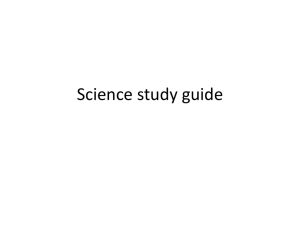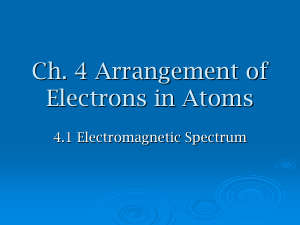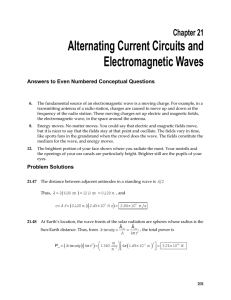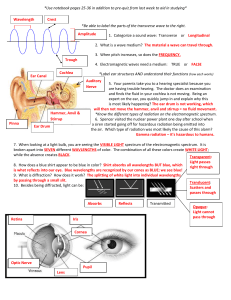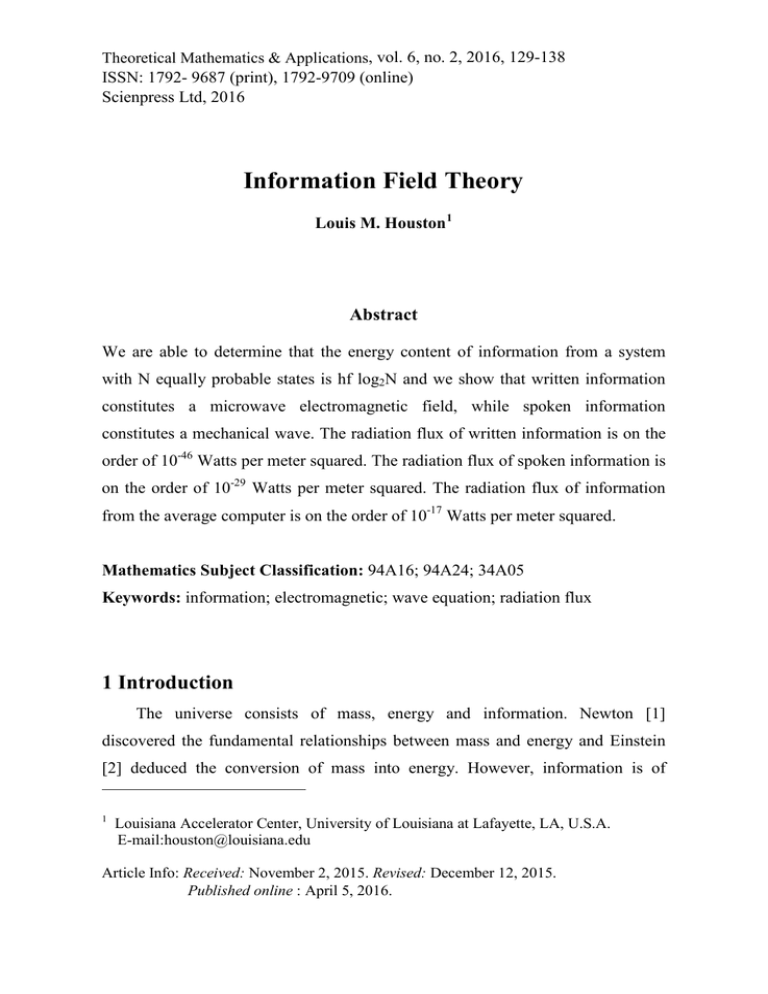
Theoretical Mathematics & Applications, vol. 6, no. 2, 2016, 129-138
ISSN: 1792- 9687 (print), 1792-9709 (online)
Scienpress Ltd, 2016
Information Field Theory
Louis M. Houston 1
Abstract
We are able to determine that the energy content of information from a system
with N equally probable states is hf log2N and we show that written information
constitutes a microwave electromagnetic field, while spoken information
constitutes a mechanical wave. The radiation flux of written information is on the
order of 10-46 Watts per meter squared. The radiation flux of spoken information is
on the order of 10-29 Watts per meter squared. The radiation flux of information
from the average computer is on the order of 10-17 Watts per meter squared.
Mathematics Subject Classification: 94A16; 94A24; 34A05
Keywords: information; electromagnetic; wave equation; radiation flux
1 Introduction
The universe consists of mass, energy and information. Newton [1]
discovered the fundamental relationships between mass and energy and Einstein
[2] deduced the conversion of mass into energy. However, information is of
1
Louisiana Accelerator Center, University of Louisiana at Lafayette, LA, U.S.A.
E-mail:houston@louisiana.edu
Article Info: Received: November 2, 2015. Revised: December 12, 2015.
Published online : April 5, 2016.
130
Field Theory
growing importance and the relationship between information and energy is a
subject of great interest [3].
The mathematical theory of information specifies an equation for information
that is solely based on probability and is similar in form to entropy in physics [4].
However, the theory does not include energy.
The black hole information paradox results from the combination of quantum
mechanics and general relativity [5]. It suggests that physical information could
permanently disappear in a black hole, allowing many physical states to devolve
into the same state. This is controversial because it violates a commonly assumed
tenet of science—that in principle complete information about a physical system
at one point in time should determine its state at any other time [6]. A fundamental
postulate of quantum mechanics is that complete information about a system is
encoded in its wave function up to when the wave function collapses [7]. The
evolution of the wave function is determined by a unitary operator [8], and
unitarity implies that information is conserved in the quantum sense. This is the
strictest form of determinism.
Currently, the most specific relationship between energy and information is
due to Landauer’s limit [9], which states that the minimum amount of energy
required to erase one bit of information is kTln2. The result is derived from
thermodynamics [10].
In this paper, we employ set theory [11] to derive the observational energy
required by information. We use that energy to determine an information field that
causes a force of attraction between units of information. The field is then given
spatial and temporal dependence in the form of a traveling wave with a random
phase. The random phase satisfies the requirement that information is
unpredictable. The wave equation is inhomogeneous [12], but it is approximately
homogeneous [13] for certain relationships between wave speed and temporal
frequency. The homogenous approximation creates an electromagnetic field [14].
We simply correlate this field to the way written information is read and we do an
Louis M. Houston
131
example calculation to demonstrate the level of the radiation flux [15]. We also
characterize the information carried by sound and other compressional waves.
2 Theory
Consider the following wave function with a time-variant phase:
(1)
It satisfies the equation:
(2)
Let
φ( t ) = Xt , X ∈ [0,2πΗz], X : Ω → R
(3)
Equation (2) has a random phase [16] for condition (3) and becomes:
(4)
Equation (4) characterizes an information wave. The information pattern is a result
of the random phase of the wave.
We can derive the following homogeneous wave from (4):
(5)
We can consider a related field:
(6)
We see that the following conditions hold:
(7)
Therefore, this yields an electromagnetic field that must satisfy Maxwell’s
132
Field Theory
equations [12]:
(8)
(9)
(10)
(11)
The radiation flux is given by:
(12)
Therefore, the radiation flux of the original fields is:
(13)
If we consider that written information has a typical wavelength between 0.1 cm
and 100 cm, the wavelength of microwaves, then we know that the average
frequency of written information is 150 GHz. Consequently,
ω
c
2
= 1,04 × 10 −5 ≈ 0
(14)
This is consistent with (5) so that written information becomes an electromagnetic
wave or microwave [17]. The diagram:
↑→ ⊕
(15)
shows the directions of the electromagnetic fields and their radiation flux. This is
consistent with reading information from left to right and receiving the
information flux perpendicular to that direction out of the page.
We can apply this to spoken information. The average frequency of the human
voice is 200 Hz. The speed of sound is 340 m/s.
Louis M. Houston
ω
c2
133
= 0,01 ≈ 0
(16)
In this case, the information wave is not an electromagnetic wave, but a
mechanical wave [18]. This is consistent with the fact that for information
transported by sound, the radiation flux is parallel to the wave.
Consider the case of a wireless computer network.
The average frequency of a
desktop computer is 2 GHz. The wireless signal moves at the speed of light.
ω
c
2
= 7 × 10 −6 ≈ 0
We now want to determine the amount of energy contained in information. That
will allow us to designate 𝛼0 . Consider the following theorem:
Theorem 1 There are log2N units of observational energy needed to locate one out
of N equally probable symbols.
Proof. Detection of a symbol requires observational energy, 𝜉. Let the total set of
equally probable symbols be S. Suppose we are looking for the symbol a. The
number of distinct symbols is N.
If N=1, we have located a with a cost of zero energy. If N=2, divide S into two
subsets containing one element each: S1 ∪ S 2 = S , S1 = S 2 = 1 .
Observe S1 for a. The cost is 𝜉.
α ∈ S1 ⇒ α ∉ S 2 , α ∉ S1 ⇒ α ∈ S 2 .
Therefore, if N=2, we can locate a with a cost of 𝜉.
If N=4, divide S into two subsets containing two elements each:
S1 ∪ S 2 = S , S1 = S 2 = 2 . Observe S1 for a. The cost is 𝜉.
α ∈ S1 ⇒ α ∉ S 2 , α ∉ S1 ⇒ α ∈ S 2
If a∈S1, divide S1 into two subsets containing one element each:
S11 ∪ S12 = S1 , S11 = S12 = 1 . Observe S11 for a. The cost is 𝜉.
134
Field Theory
α ∈ S11 ⇒ α ∉ S12 , α ∉ S11 ⇒ α ∈ S12 .
Therefore, if N=4, we can locate a with a cost of 2𝜉.
If N=8, divide S into two subsets containing four elements each:
S1 ∪ S 2 = S , S1 = S 2 = 4 . Observe S1 for a. The cost is 𝜉.
α ∈ S1 ⇒ α ∉ S 2 , α ∉ S1 ⇒ α ∈ S 2 .
If a∈S1, divide S1 into two subsets containing two elements each:
S11 ∪ S12 = S1 , S11 = S12 = 2 . Observe S11 for a. The cost is 𝜉.
α ∈ S11 ⇒ α ∉ S12 , α ∉ S11 ⇒ α ∈ S12 .
If a∈S11, divide S11 into two subsets containing one element each:
S111 ∪ S112 = S11 , S111 = S112 = 1 . Observe S111 for a. The cost is 𝜉.
α ∈ S111 ⇒ α ∉ S112 , α ∉ S111 ⇒ α ∈ S112 .
Therefore, if N=8, we can locate a with a cost of 3𝜉.
We can make a table of our results:
N
cost
1
0
2
ξ
4
2ξ
8
3ξ
This correlates to the formula:
Ε = ξ log 2 N
(17)
The observational energy is equivalent to the electromagnetic energy used for
observation. Therefore, the energy contained within information is:
Ε = hf log 2 N
(18)
Equation (16) implies that we can write:
Fx = hf log 2 N
Or:
(19)
Louis M. Houston
Ε=
hf log 2 N
x
135
(20)
We propose that information is attractive so that if there are two information
systems with N1 and N2 states, then the force between them is:
(21)
Equation (19) suggests that the field due to the second system can be written as:
(22)
This is consistent with positive information current moving from left to right and
negative information current moving from right to left. The charge to the left is
positive, while the charge to the right is negative. [This is the case for English, but
in general, the polarity is dependent upon the language. In either case, the
radiation flux is still in the positive z direction or out of the page.]
A time-dependent, random phase modulation of (21) yields:
(23)
If we suppress the indices, we get:
(24)
Equation (23) gives the wave function given in (1) with:
α 0 = hf log 2 N
(25)
The radiation flux can therefore be written as:
(26)
[The units are corrected by multiplying the result by 1 C2. Note that the radiation
flux is in Watts per square meter.]
136
Field Theory
Examples
1. Calculate the radiation flux of the information wave due to written
information that has a separation of one centimeter:
(27)
2. Calculate the radiation flux of the information wave due to the human
voice over a separation of one meter:
hf 2 log 2 N
P
=
≈ 10 −29 W 2
2
m
A
m
(28)
3. Calculate the radiation flux of the information wave due to a wireless
computer network at a separation of 10 meters:
hf 2 log 2 N
P
=
≈ 10 −17 W 2
2
m
A
m
(29)
3 Conclusion
We have determined the energy contained in information and derived the
information field equations. The equations specify that written information is an
electromagnetic field that is comprised of microwaves. The radiation flux of the
information field is consistent with the reading of information because the
information content is collected in a perpendicular direction to the flow of
information symbols. We also characterize the information wave carried by sound
and other compressional waves and we find that the radiation flux of information
carried by a computer is orders of magnitude greater than the radiation flux of
sound and written information.
Although the radiation flux of information is extremely small, the results of
this paper might be used to measure the radiation flux of information in different
environments.
Louis M. Houston
137
References
[1] S. D. Snobelen, Isaac Newton, heretic: the strategies of a Nicodemite, British
Journal for the History of Science 32(4), (1999), 381-419.
[2] A.
Einstein,
Kosmolugische
Betrachtungen
Zur
Allgemeinen
Relativitatstheorie, Physikalische Zeitschrift, 18, (1917b), 121-128.
[3] J.D. Bekenstein, Universal upper bound on the entropy-to-energy ratio for
bounded systems, Phys. Rev. D., 23(2), (1981), 287-298.
[4] C.E. Shannon, A Mathematical Theory of Communication, Bell System
Technical Journal, 27(4), (1948), 623-656.
[5] S.Hawking, Particle creation by black holes, Commun. Math. Phys., 43(3),
(1975), 199-220.
[6] R.G. Swinburne, Physical Determinism, Royal Institute of Philosophy
Lectures 3, (1969), 155-168.
[7] J.Mehra and H. Rechenberg, The historical development of quantum theory,
New York, Springer-Verlag, 1982.
[8] P. Halmos, A Hilbert space problem book, Springer, 1982.
[9] R. Landauer, Irreversibility and heat generation in the computing process,
IBM Journal of Research and Development, 5(3), (1961), 183-191.
[10] W. Thomson, Thermo-Electric Currents, Transactions of the Royal Society of
Edinburgh, 21(part 1), (1854), 123.
[11] G. Cantor, Uber eine Eigenschaft des Inbegriffes Aller reellen Algehreis-chen
Zahlen, J. Reine Angew. Math., 77, (1874), 258-262.
[12] J.C. Maxwell, A dynamical theory of the electromagnetic field, Philosophical
Transactions of the Royal Society of London, 155, (1864), 455-512.
[13] G.F. Wheeler, The Vibrating String Controversy, Am. J. Phys., 55, (1987),
33-37.
[14] R.K. Wangsness, Electromagnetic Fields, (2nd Ed.), Wiley, 1986.
[15] J.H. Poynting, On the Transfer of Energy in the Electromagnetic Field,
138
Field Theory
Philosophical Transactions of the Royal Society of London 175, (1884),
343-361.
[16] M. Hazewinkel, Random variable, Encyclopedia of Mathematics, Springer,
2001.
[17] P.J. Mohr, B.N. Taylor and D.B. Newell, CODATA recommended values of
the fundamental physical constants: 2006, Mod. Phys., 80(21), (2008),
633-730.
[18] D.C. Giancoli, Physics for scientists & engineers with modern physics,
Pearson-Prentice Hall, 2009.



